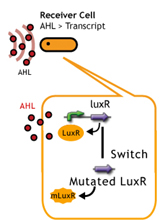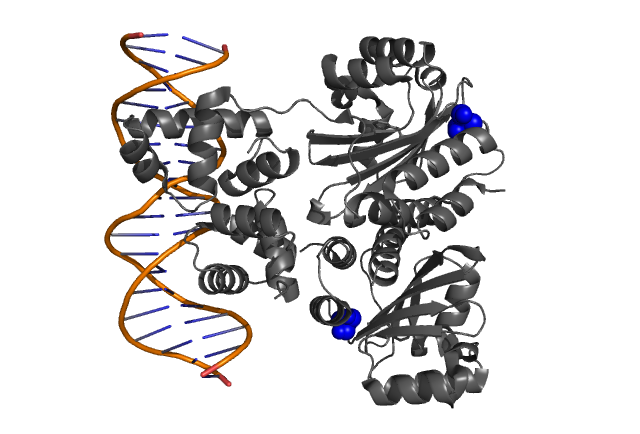Team:Chiba/Experiments:LuxR mutant
From 2008.igem.org
(Difference between revisions)
(→Experiment) |
(→Design) |
||
| Line 21: | Line 21: | ||
| width="50%" valign="top"| | | width="50%" valign="top"| | ||
| - | [[Image:Mutant-LuxR Chiba.gif|frame|right|'''Fig.4.2''' Seisitivity of LuxR mutants. Data modified from Collins et.al. Mol. Microbiol. 55, 712–723 (2005)]] | + | [[Image:Mutant-LuxR Chiba.gif|frame|right|'''Fig. 4.2''' Seisitivity of LuxR mutants. Data modified from Collins et.al. Mol. Microbiol. 55, 712–723 (2005)]] |
[[Image:AHL-activation-of-mutagenizenized LuxR molecules Chiba.gif|frame|right|'''Fig.4.3''' Ahl activation of mutagenized LuxR molecules. '''Data modfied from B.Kock et al. Microbiology (2005), 151, 3589-3602''']] | [[Image:AHL-activation-of-mutagenizenized LuxR molecules Chiba.gif|frame|right|'''Fig.4.3''' Ahl activation of mutagenized LuxR molecules. '''Data modfied from B.Kock et al. Microbiology (2005), 151, 3589-3602''']] | ||
| Line 27: | Line 27: | ||
|} | |} | ||
| - | + | [[Image:LuxR I46F chiba.png|thumb|right|'''Fig. 4.3'''Ile45Phe mutation]] | |
| + | [[Image:LuxR L42S chiba.png|thumb|right|'''Fig. 4.4'''Leu45Ser mutation]] | ||
Collins et.al. described the hyper-sensitive variants of luxR to AHL.[[Team:Chiba/Experiments:LuxR mutant#Reference|<sup>(1)</sup>]] | Collins et.al. described the hyper-sensitive variants of luxR to AHL.[[Team:Chiba/Experiments:LuxR mutant#Reference|<sup>(1)</sup>]] | ||
CollonsらとKockらによって、LuxRに変異を入れることでLuxRのAHLに対する感受性を変えることができると報告されている。[[Team:Chiba/Experiments:LuxR mutant#Reference|<sup>(1),(2)</sup>]] | CollonsらとKockらによって、LuxRに変異を入れることでLuxRのAHLに対する感受性を変えることができると報告されている。[[Team:Chiba/Experiments:LuxR mutant#Reference|<sup>(1),(2)</sup>]] | ||
| - | # | + | #Ile45Phe(Fig. 4.3)とするとAHLに対する感受性が約10倍上昇する[[Team:Chiba/Experiments:LuxR mutant#Reference|<sup>(1)</sup>]] |
#Leu42AlaとするとAHLに対する感受性が1/15に減少する[[Team:Chiba/Experiments:LuxR mutant#Reference|<sup>(2)</sup>]] | #Leu42AlaとするとAHLに対する感受性が1/15に減少する[[Team:Chiba/Experiments:LuxR mutant#Reference|<sup>(2)</sup>]] | ||
| - | # | + | #Leu42Ser(Fig. 4.4)とするとAHLに対する感受性が1/1000に減少する[[Team:Chiba/Experiments:LuxR mutant#Reference|<sup>(2)</sup>]] |
<br clear=all> | <br clear=all> | ||
Revision as of 02:28, 30 October 2008
| Home | The Team | The Project | Parts Submitted to the Registry | Reference | Notebook | Acknowledgements |
|---|
LuxR mutant (Under Planning)
Design
|
|
|
Collins et.al. described the hyper-sensitive variants of luxR to AHL.(1) CollonsらとKockらによって、LuxRに変異を入れることでLuxRのAHLに対する感受性を変えることができると報告されている。(1),(2)
- Ile45Phe(Fig. 4.3)とするとAHLに対する感受性が約10倍上昇する(1)
- Leu42AlaとするとAHLに対する感受性が1/15に減少する(2)
- Leu42Ser(Fig. 4.4)とするとAHLに対する感受性が1/1000に減少する(2)
Experiment
Sender; LuxI plasmid transformed into E.coli strains (JW1908)
Receiver; LuxR-gfp plasmid transformed into E.coli strains (JW1908)
Culture/ Cndn.
- Both Sender and Receiver (+/- Mutation) were inoculated into small (2mL) culture and was shaken separately for 12h (at 37C)
- Inoculated into flesh media, shaken until cell density hit 2.0 in OD600
- Washed the cell and re-suspended. Cell density checked.
- Mixed Sender and Receiver (Sender/Receiver 1000μl/1000μl).
- Incubated at 30°C.
- Time-chased the fluorescence (485nm(excitation) and 527nm(emission)) by gfp.
|
|
| [http://partsregistry.org/Part:BBa_S03623 BBa_S03623] |
|
|
Reference
- Collins et.al. Directed evolution of Vibrio fischeri LuxR for increased sensitivity to a broad spectrum of acyl-homoserine lactones. Mol. Microbiol. 55, 712–723 (2005)
- B.Koch et.al.:The LuxR receptor: the sites of interaction with quorum-sensing signals and inhibitors. Microbiol. 2005 Nov;151(Pt 11):3589-602.
| Home | The Team | The Project | Parts Submitted to the Registry | Notebook |
|---|
 "
"






